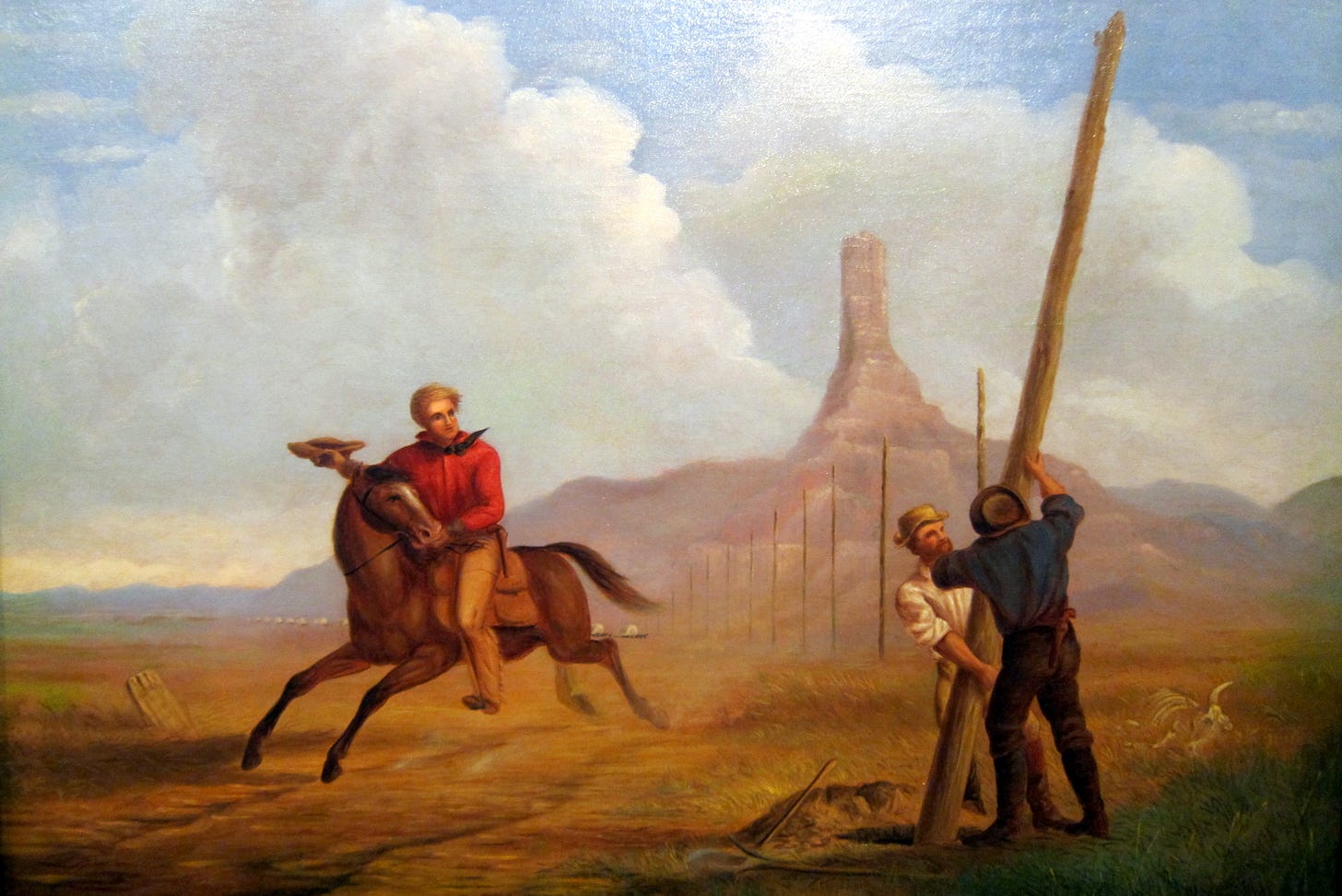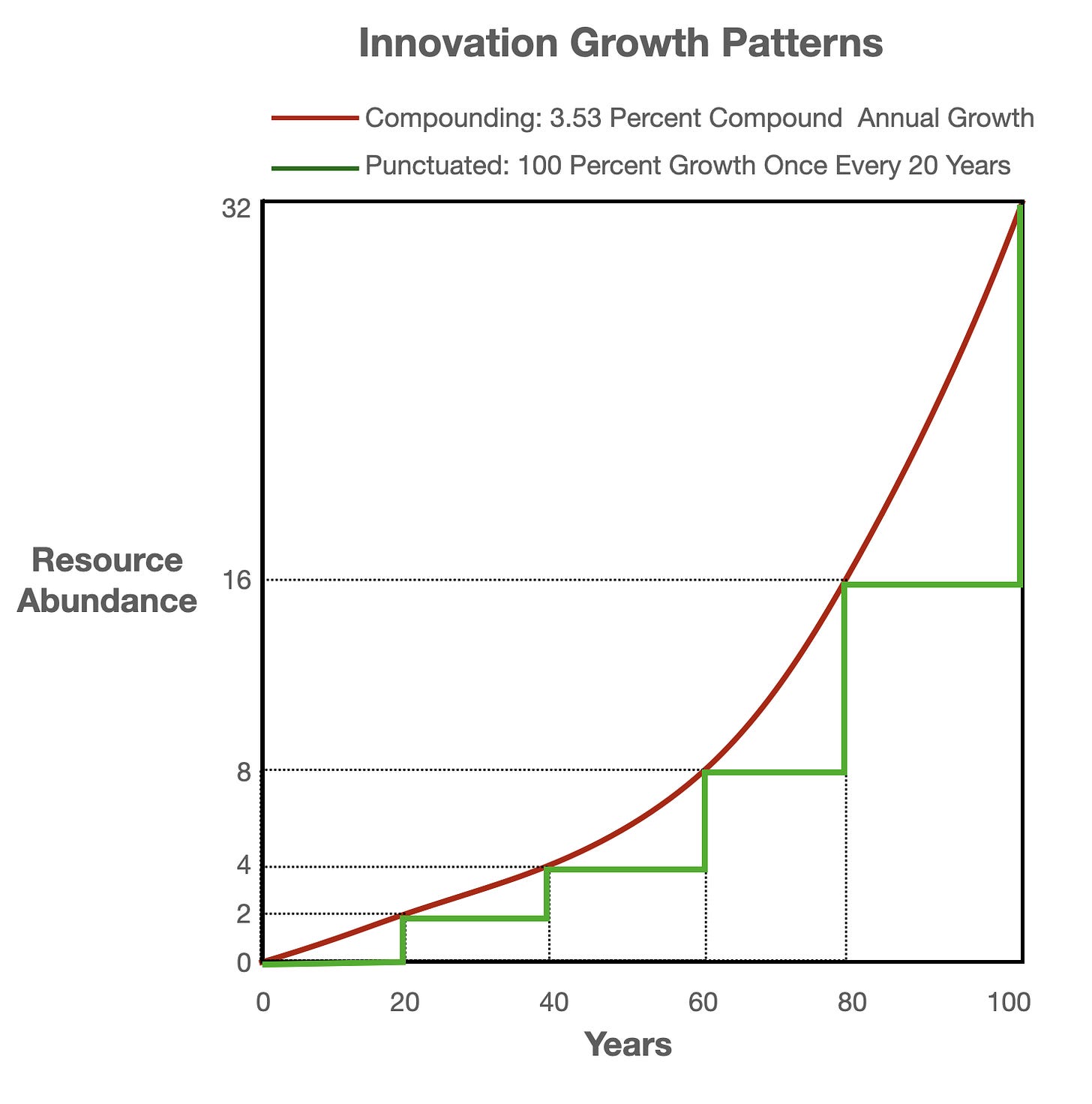Ponies, Trains, and Telegraphs: Punctuated and Compounding Innovation
3.5 percent growth a year doesn't seem like much, but it doubles size every 20 years.
Innovation can occur in dramatic bursts. Like when the telegraph replaced the Pony Express. The innovative Pony Express had cut previous delivery times in half and reigned for 18 months as the fastest way to deliver information across the United States. The service was introduced on April 3, 1860 and delivered mail between St. Joseph, Missouri and Sacramento, California. The 2,000-mile route took approximately 10 days with riders traveling 75 to 100 miles each, switching horses every 10–15 miles.
Western Union erected the first telegraph poles on July 4, 1861 and took 112 days to complete the first electronic transcontinental communication system on Oct. 24, 1861. Two days later the Pony Express was discontinued.
The 1,912 mile transcontinental railroad connecting Council Bluffs, Iowa to San Francisco started in 1863 and was completed on May 10, 1869. Traversing rivers and mountains with bridges and tunnels, railroads were on fast learning curves in their race to connect the continent. Today trains can move one ton of freight approximately 492 miles on a single gallon of fuel.
The Pony Express was an innovation that reduced the time to deliver a message by 50 percent. Eighteen months later it was innovated out of business. We call these events “punctuated” innovation. But they are rather rare. In most cases innovation is a slow meticulous process growing at 3 to 4 percent a year. This is compounding innovation.
What would you prefer? Abundance doubling once every twenty years, or abundance increasing 3.5 percent every year? Both rates yield the same result every 20 years.
We measure the abundance innovation creates in time prices, or the time required to earn the money to buy something. Time prices are the ratio of the money price divided by hourly income. Money prices are expressed in dollars and cents and time prices are expressed in hours and minutes. For example, if pizzas cost $15 in 2015 and you were earning $15 an hour, a pizza costs you 60 minutes. If the price of pizza increased to $18 in 2020 but your hourly income increased to $20 and hour, your time price would be 54 minutes. The time price has decreased by 10 percent. For the time required to earn a pizza in 2015, you will get 1.11 pizzas in 2020. Your can say your pizza abundance has increased by 11 percent.
Innovation occurs when it takes less time to buy something, or you get more for the same time. As time prices decrease, abundance increases geometrically. If the time required to earn the money to buy something falls by 50 percent, devoting the same amount of time will get you 100 percent more. A 75 decrease in time prices will give you 300 percent more for the same time. And a 90 percent decrease will yield 900 percent more.
When we measured the time prices of 50 basic commodities from 1980 to 2020, we discovered that the average time price had fallen by -75.2 percent, with a range of -24.4 percent for iron ore to -86.2 percent for sugar. A -75.2 percent decrease in the time price corresponds to a 303 percent increase in abundance. For the time required to earn the money to buy one item in 1980, you would get 4.03 items in 2020. Going from one to 4.03 in 40 years indicates a compound annual growth rate of 3.55 percent. At this rate, abundance doubles every 19.9 years.
Punctuated innovation gets lots of attention, but compounding innovation is lifting us out of poverty into a world of superabundance, where personal resource abundance is increasing much faster than population.
Global resources can be measured as personal resource abundance multiplied by population. From 1980 to 2020 personal resources increased by 303 percent while global population increased by 75.8 percent. This suggests that global resources increased by 608 percent ((4.03 x 1.758) - 1). Every one percent increase in population corresponded to a 8 percent increase in global resource abundance. Where else can you get this kind of return on an investment?
The Pony Express was created by young, innovating, and risk-taking Americans. Western Union continued the growth in abundance with the telegraph. Railroad companies learned how to create a global transportation system. As Julian Simon frequently observed, free and creative human beings are the ultimate resource.
Excerpt from our forthcoming book, The Age of Superabundance






I don't think the Pony Express ever thought Western Union could build their telegraph line so fast. Even Abraham Lincoln was aware of the difficulty of the proposal, saying, “I think it is a wild scheme. It will be next to impossible to get your poles and materials distributed on the plains, and as fast as you complete the line, the Indians will cut it down.” So much for expert opinion.
"Western Union erected the first telegraph poles on July 4, 1861 and took 112 days to complete the first electronic transcontinental communication system on Oct. 24, 1861. Two days later the Pony Express was discontinued."
If only we could all know just when to stop.